Speech Australia and Canada – Shared Experiences
Thank you for inviting me to address this year's Australia-Canada Leadership Forum. It is a real pleasure for me to be here.
The original plan for this session was to have Bank of Canada Governor, Steve Poloz, also speak. But the timing of the Bank of Canada's next regular monetary policy meeting has meant that this wasn't possible. Like us, the Bank of Canada has a blackout period around their policy meetings. So this means that I will need to wait for a future occasion to welcome Governor Poloz to Australia.
The Bank of Canada and the Reserve Bank of Australia enjoy a very warm relationship. Many of the issues we face are similar and our perspectives are often very close to one another. This is partly because of the similarities in our economies. But it is also because Australians and Canadians are both pragmatic and open-minded people and we don't take ourselves too seriously. So, there is a natural affinity.
On the economic front, we are both medium-sized trading nations. We are both rich in natural resources. We have both had to come to terms with volatile prices for our key exports. We both have strong and resilient banking systems. We both have floating exchange rates and we operate flexible inflation targets. We are both attractive places for non-residents to invest their savings. We both have growing populations. And we both have had to deal with very large increases in housing prices in some of our cities. With all this in common, it is not surprising that we find much to talk about and experiences to share.
Australia and Canada are also both countries that have benefited greatly from international trade. We are both strong supporters of a rules-based open international trading system.
Too often these days, a commitment to open international trade, integration into global capital markets, a strong role for markets and a dynamic financial sector are seen as liabilities, not as assets. Australia and Canada provide strong counter examples. We show that openness can deliver both prosperity and resilience. We both enjoy standards of living that relatively few people elsewhere in the world enjoy. And while our economies have had their ups and downs, they have also proved to be pretty resilient.
Australians and Canadians also understand that the benefits from openness can fall unevenly across our communities. We recognise that while openness makes the size of the pie bigger, it can also affect the distribution of the pie in a way that our societies feel uncomfortable with. This is something that we have both tried to address and have had more success on this front than some other countries.
With that introduction, the main focus of my remarks this morning is on the outlook for the Australian economy. I would like to talk about this outlook in the context of three issues that I hope will have strong resonance with the Canadians in the audience. The first of these is the cycle in investment in the resources sector. The second is developments in the housing market and household borrowing. And the third is inflation targeting in a low inflation, low interest rate environment.
The Outlook
The RBA released its latest economic forecasts a couple of weeks ago.
We expect economic growth to be around 3 per cent over the next couple of years. This is a little faster than our current estimate of the potential growth of our economy. Despite this, we do not expect much change in the current rate of unemployment, which stands at around 5¾ per cent. This is because some of the above-potential growth is a result of the expansion of LNG production, which does not employ that many people.
Given this outlook, we expect underlying inflation to increase, but to do so only gradually. Wage growth remains subdued, but is not expected to decline further, and spare capacity is likely to remain in the economy for some time yet. Our central forecast is for headline inflation to increase to above 2 per cent later this year, boosted by increases in oil and tobacco prices. The increase in underlying inflation is expected to be a bit more gradual.
Commodities and Investment
The first of the three issues that I expect will strike a resonance with Canadians is the shifts in commodity prices and investment in the resources sector. This is a major factor that has shaped economic outcomes in both our countries.
While the general stories are similar, the details are different. One area of difference is the size of the movements in the prices of our main exports, summarised in the terms of trade (Graph 1). Australia's terms of trade almost doubled over the first decade of this century and in 2011 reached their highest level since the gold rushes of the 1850s. The increase in Canada was also large in a historical context, although it was not as large as that in Australia.

This difference reflects two factors. The first is that the prices of Australia's main commodity exports – iron ore and coal – increased by significantly more than the price of Canada's main commodity export, oil. The short-run supply curve in iron ore and coal tends to be very steep, so the prices for these steel-making commodities increased very sharply when Chinese investment in property and infrastructure really took off. The second factor is that commodities make up a larger share of Australia's total exports than is the case for Canada.
Both of our countries have also experienced a pronounced cycle in mining investment. Not surprisingly, reflecting the larger movement in our commodity prices, the cycle has been bigger in Australia. Here, mining investment went from 2 per cent of GDP in the early 2000s to 9 per cent in 2012 (Graph 2). Another difference with Canada is that our main export partner, China, has grown at an average rate of almost 10 per cent over this period, compared with just 2 per cent average growth in Canada's main export partner, the United States.

Both our countries accommodated the increase in mining investment without overheating. Our flexible exchange rates played an important role here.
Given the larger cycle in mining investment here, the impact on the rest of the economy has been more pronounced. While many parts of our economy did well from the boom in mining investment, others did not as they dealt with the higher exchange rate and found it difficult and more expensive to hire workers. One illustration of this broad impact is the substantial decline in Australia in non-mining investment as a share of GDP from the mid 2000s (Graph 2). By way of contrast, Canadian non-mining investment has shown much less variation.
For some time, a major factor shaping our forecasts for the Australian economy has been a rebalancing of investment between the resources and non-resources sectors. We estimate that the decline of mining investment back to normal levels is around 90 per cent done. So this headwind, which has been weighing on GDP growth for some time, will blow itself out before too long.
Another headwind we have had for some years is the fall in commodity prices, but this has turned into a gentle tailwind since mid last year. Since then the prices of all our main commodity exports have risen. This is good news for us, although we are not expecting the higher prices to lead to the type of pick-up in investment in the resources sector that might once have occurred. There has already been a very large expansion in supply capacity and we expect some unwinding of the recent increase in prices as supply increases. The higher prices, though, are providing a boost to our national income and this is expected to have some flow-through effects to the rest of the economy.
The other part of the story has been the expected pick-up in non-mining investment. This pick-up has been a long time coming. As in Canada, the picture is complicated by significant differences across regions. In those parts of Australia where mining investment has been declining, non-mining investment has also been falling because of the significant spill-over effects (Graph 3). Elsewhere, the picture is more encouraging. Non-mining investment has now picked up in New South Wales and Victoria. Survey measures of capacity utilisation have increased and so too have broader-based measures of business conditions. So while the near-term outlook for non-mining investment for the country as a whole remains subdued, we continue to forecast a pick-up later in the forecast period.

Housing and Borrowing
I would now like to turn to a second issue that I think will strike resonance with Canadians: housing prices and borrowing. This is an issue that is discussed a lot in both our countries. We have both had strong housing markets over recent years and there are concerns about the level of household indebtedness. There are some similarities in the factors at work.
One is that our populations have been growing quickly for advanced industrialised countries. In Australia, population growth has averaged 1.7 per cent over the past decade, while in Canada it has averaged 1.1 per cent. Over the past couple of years the growth rates have moved closer together.
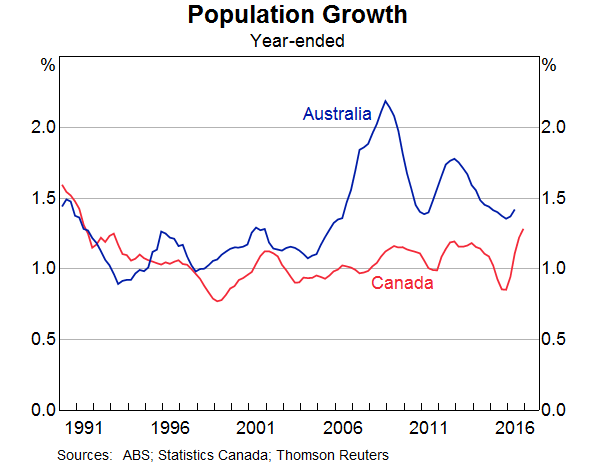
Another similarity is that there has been strong demand from overseas residents for investments in residential property, particularly in our wonderful Pacific-rim cities. Not only are these cities attractive places to live, but we also offer investors security of property rights and economic and financial stability. Given the strong demand and its impact on prices in some areas, some state and provincial governments have recently levied additional taxes on foreign investors in residential property.
Our housing markets have also been affected by the global monetary environment. We both run independent monetary policies, but the level of our interest rates is influenced by what happens elsewhere in the world. With interest rates so low and our economies being resilient, it is not so surprising that people have found it an attractive time to borrow to buy housing.
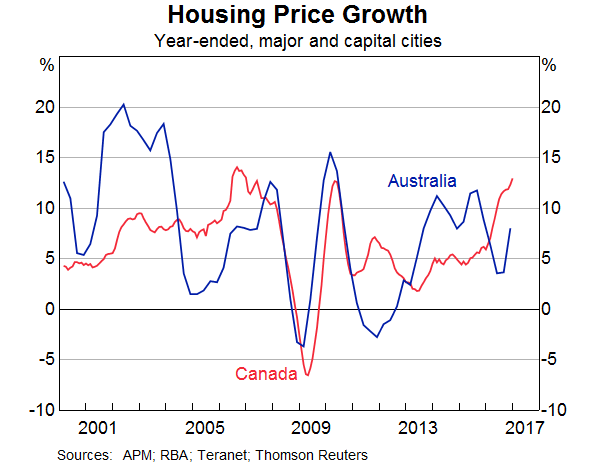
Another characteristic that we have in common is that at a time of strong demand from both residents and non-residents, there are challenges on the supply side. I understand that zoning is an issue in Canada, just as in Australia. In some parts of Australia, there has also been underinvestment in transport infrastructure, which has limited the supply of well-located land at a time when demand for such land has been growing quickly. The result is higher prices.
We are also both experiencing large differences across the various sub-markets within our countries. The strength in housing markets in our major cities contrasts with marked weakness in the mining regions following the end of the mining investment boom (Graph 6).
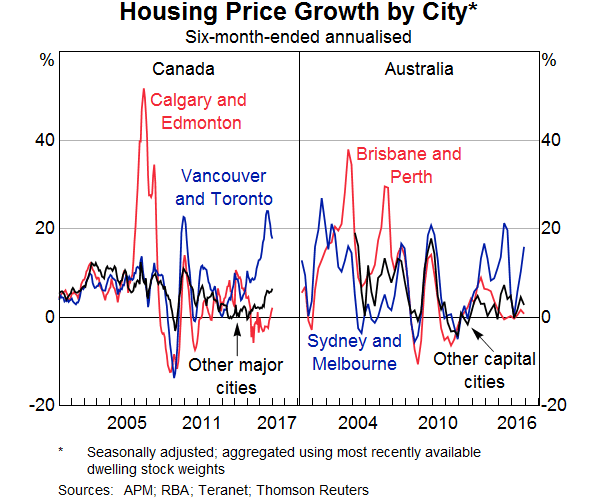
The increase in overall housing prices in both our countries has gone hand in hand with a further pick-up in household indebtedness (Graph 7). In both countries the ratio of household debt to income is at a record high, although the low level of interest rates means that the debt-servicing burdens are not that high at the moment.
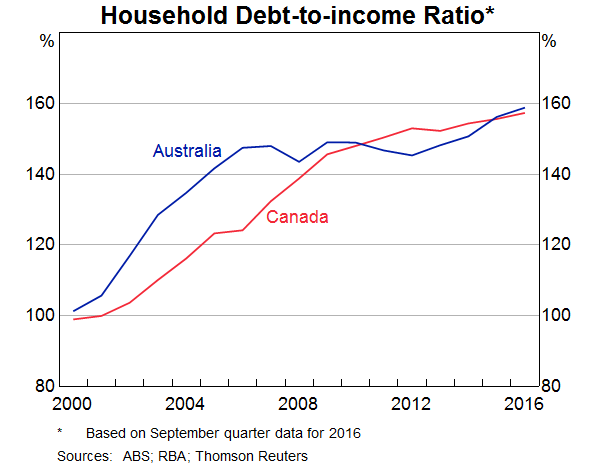
In Australia, the household sector is coping reasonably well with the high levels of debt. But there are some signs that debt levels are affecting household spending. In aggregate, households are carrying more debt than they have before and, at the same time, they are experiencing slower growth in their nominal incomes than they have for some decades. For many, this is a sobering combination.
Reflecting this, our latest forecasts were prepared on the basis that growth in consumption was unlikely to run ahead of growth in household income over the next couple of years; in other words the household saving rate was likely to remain constant. This is a bit different from recent years, over which the saving rate had trended down slowly (Graph 8).
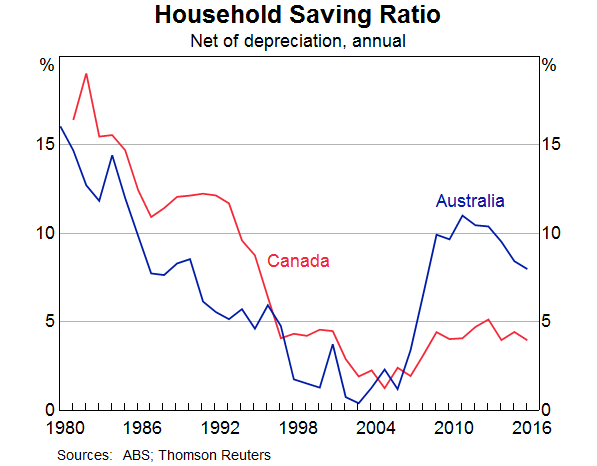
This interaction between consumption, saving and borrowing for housing is a significant issue and one that I know both central banks are watching carefully. It is one of the key uncertainties around our central scenario for the Australian economy. It was also cited as one of the key risks for the inflation outlook in the Bank of Canada's latest Monetary Policy Report. We are still learning how households respond to higher debt levels and lower nominal income growth.
Inflation Targeting in a Low Inflation Environment
I would now like to turn to a third issue where there is some commonality of experience: that is dealing with an extended period of low inflation.
For a few years now, both countries have experienced low rates of inflation (Graph 9). Many of the same factors have been at play. Wage growth has been subdued given the ongoing slack in the labour market. We have both also seen downward pressure on retail prices from intensified competition. In its latest Monetary Policy Report, the Bank of Canada noted that this was one issue affecting food prices. The same is true in Australia, but the experience here is broader, with new entrants, including overseas retailers, putting downward pressure on the prices of a wide range of goods.

We are both expecting inflation to increase, but only gradually so. In our case, we expect the disinflationary effects of the earlier decline in commodity prices and the competitive pressures in retailing to wane. Some pick-up in wages growth is also expected, although wage increases are likely to remain below average for some time yet. Our liaison with businesses does not suggest that a pick-up in wage growth is imminent, but nor does it suggest that a further slowing is in prospect.
Over recent times, both central banks have had to think about the implications for their monetary policy frameworks of sustained low inflation and rapid increases in borrowing and housing prices. Both have recently reaffirmed that inflation targeting remains the right monetary policy framework.[1] We have also emphasised that our inflation targets are flexible, not rigid straightjackets. In our case, the emphasis is very much on medium-term outcomes, rather than the outcome over any particular period.
While there are some differences in emphasis in language, there is a high degree of commonality in our approaches. Governor Poloz has said on a number of occasions that the Bank of Canada takes a ‘risk management approach’ to monetary policy.[2] This strikes a very strong resonance with us at the Reserve Bank of Australia.
At any point in time there are quite a few possible paths that the cash rate could follow to achieve Australia's inflation target, which is to achieve an average rate of inflation over time of 2 point something. Consistent with the Reserve Bank Act, we set out to choose the path that, in our judgement, best promotes the welfare of the Australian people.
In our risk management exercises, we have been seeking to balance the risks from having inflation low for a longer period against the risks from attempting to increase inflation more quickly, which would partly occur through encouraging more borrowing.
If inflation is low for a long period of time, it is certainly possible that inflation expectations adjust, making it harder to achieve the objective. At the moment though, I don't see a particularly high risk of this in Australia. The recent lift in headline inflation is helpful here and most measures of inflation expectations are within the range seen over recent decades.
In relation to the risks from additional borrowing, it is possible that continuing rises in indebtedness, partly as a result of low interest rates, increase the fragility of household balance sheets. If so, then at some point in the future, households having decided that they had borrowed too much, might cut back consumption sharply, hurting the overall economy and employment. It is difficult to quantify this risk, but it is one that is difficult to ignore. As I said, our focus is on the medium term, not just the next year or so.
Another consideration in thinking about the risks are the trends in the labour market. All else constant, if the unemployment rate is high and rising, the stronger would be the case for policy to pursue a quicker return of inflation to the midpoint of the target. To date, we have been satisfied that the labour market is heading in the right direction, if not as quickly as we'd like. After declining over 2015, our unemployment rate has been broadly steady, with employment growth concentrated in part-time jobs. And like the housing market, the labour market outcomes vary significantly across the country. So it is an area that we continue to watch carefully.
In summary then, flexible inflation targeting with a medium-term focus remains the right monetary policy framework for Australia. In both Australia and Canada our monetary policy frameworks have played important roles in our economic stability of recent times. As I mentioned at the start of my remarks, we also share other strengths – a rich commodity base, strong and resilient banking systems, an attractive destination for foreign investment, flexible exchange rates and a commitment to openness and competitive markets. But overall, Australia and Canada provide pretty good advertisements for flexible inflation-targeting frameworks.
Thank you and I look forward to your questions and comments.
Endnotes
I would like to thank Andrea Brischetto for assistance in the preparation of these remarks. [*]
See Statement on the Conduct of Monetary Policy for Australia and ‘Renewal of the Inflation-Control Target’, available at <http://www.bankofcanada.ca/wp-content/uploads/2016/10/background_nov11.pdf>, for Canada. [1]
See, for example, Poloz S (2015), ‘Integrating Financial Stability into Monetary Policy’, available at <http://www.bankofcanada.ca/2015/10/integrating-financial-stability-into-monetary-policy-10102015/>, Remarks at the Institute of International Finance, Lima, Peru, 10 October. [2]
